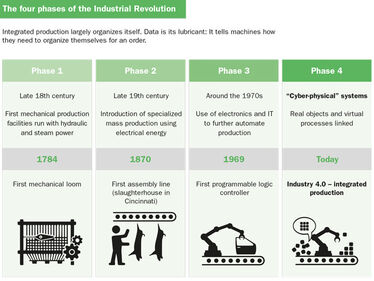
Digitization, Internet of Things, and Industry 4.0
Buzzwords dominate media and supply chain strategies. We shouldn't simply assume everyone knows what we are talking about. Let's break things down – starting with digitization.

Buzzwords dominate media and supply chain strategies. We shouldn't simply assume everyone knows what we are talking about. Let's break things down – starting with digitization.
A recent survey in Germany reported that 88% of respondents are unfamiliar with the “Internet of Things”, and 82% have never heard of the term “Industry 4.0”. This got me thinking. In our world – the world of supply chain management and global trade solutions – we have been talking about “digitization” for years, and the topic seems to be the buzzword of the day and highlight at current conferences, industry seminars, and global research studies.
The global “digitization race” among businesses across industry sectors has clearly started and reflecting upon the results of the recent German poll, I decided to take a step back and share some general information on the topic. Let’s break things down: digitization, the Internet of Things, and this strange term “Industry 4.0”, which is – albeit global – of German origin and not even there everyone knows what exactly it means. I hope this article is useful to you and sheds a bit more light on these buzzwords.
“Everything that can be digitized will be digitized.” These are not the words of some visionary researcher or advisor, as you might think – they were spoken by German Chancellor Angela Merkel, who made this bold prediction at the Economic Council’s annual Economic Conference in June 2015. So – what does it mean?
Anyone looking for a simple definition will soon realize that there is no consensus of what exactly digitization is and is not. Even Wikipedia, which often proves so useful otherwise, is of little help here. It explains digitization as “capturing an analog signal in digital form for the purposes of creating a digital representation that can be electronically stored or processed”. This is really a very narrow definition and refers to the underlying basic technology. So, are scanners and digital cameras the masters of digitization?
Maybe we should take a few more steps back. From the first cave paintings and the development of characters to the invention of printing, the evolution of mankind has always been closely linked to passing on knowledge – or information – and to keeping this knowledge safe. The invention of electrical signal transmission and electromagnetic data storage led the way to overcome limitations through space, time, and data volumes. This allowed for the sharing of messages across the globe within milliseconds, and provided an essential foundation for globalization.
The Internet forms the backbone of a global information network and with ever greater performance capacity, it makes ever greater volumes of information available – almost in real-time – to just about anywhere in the world. And for quite some time, it is no longer mankind who actually claims and utilizes this mass of information for itself. It’s in fact computers, machines, and increasingly “things” that require this data in order to process it, compute downstream results, and generate new information accordingly.
We speak of “cyber-physical systems” when such things are equipped with tiny electronic chips and sensors to interact with the environment and process data concurrently. It’s for example a fridge that is always aware of its current content, a car tire that knows its mileage throughout its entire life cycle, or the package that holds all the information about its origin and destination.
The better we can capture and process such information, the more systems get equipped with a certain “intelligence”, and the more these systems interact with each other through interconnections, the greater is the degree of digitization of such a network, for example a factory, an industry sector, or even a whole region.
And what does this development mean for the business world? Already back in 2011, the market research firm Gartner was among the first to draw a connection to added value. They defined digitization as “the use of digital technologies to change a business model and provide new revenue and value-producing opportunities.”
What’s important, in other words, is to what extent a business uses technology to enhance its own services, products, added value, and ultimately: success.
The explanations on digitization probably already help to easily pin down this term, which is abbreviated everywhere with “IoT”. But, I’ve come across a little film that I would like to share with you because it explains the matter very well. It’s also much more entertaining than my dry definitions and an excellent way to grasp the concept and its impacts – both from a professional and a personal perspective. I’ve shared it in both my work and private networks – and I hope you will do the same: watch it on YouTube.
Or “Industrie 4.0” as we’ve been reading about it in the German media for a while. It focuses on the business related developments, changes in business models, and impacts on the entire industrial sector as a result of digitization and the Internet of Things. Its effects are expected to be disruptive and long-term, and many believe those developments to bear the potential to completely transform existing value chains into entirely new ways of doing business, which is why the term refers to the fourth industrial revolution in the history of mankind (“4.0”).
The fourth stage of this industrial revolution describes “integrated production”: the real and virtual worlds are converging, and IT is becoming an inseparable element of traditional industrial systems. When they come together in a single network such as the Internet, automated and autonomous processes emerge.
One possible outcome of this development is a “smart” factory: a flexible production facility with the potential to fulfill custom, single-unit orders at a unit cost comparable to mass production. This requires an integration of not only the plants and equipment themselves but also the materials they process and parts they produce. All the elements collect real-time information (using integrated sensors, for example), process this information, and share it back and forth continuously.
This empowers such systems and their corresponding processes to run themselves. The result: The “Internet of Things,” in which people merely monitor and intervene where necessary. Acatech, the National Academy of Science and Engineering in Germany, estimates that Industry 4.0 will help businesses boost productivity by around 30%.
The shown illustration helps to recall the preceding three industrial revolutions and gives a good overview of all four revolutions to date.
